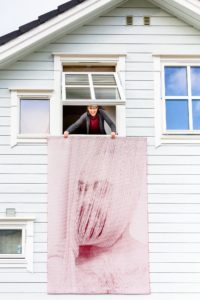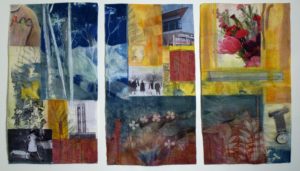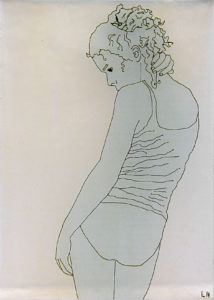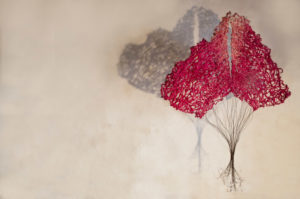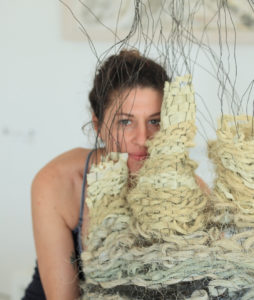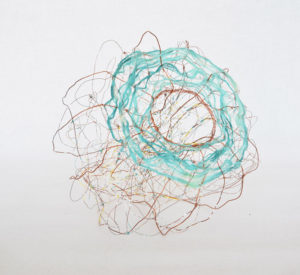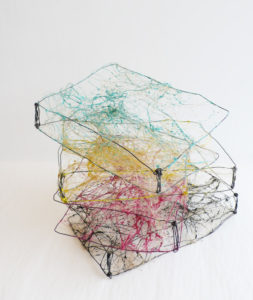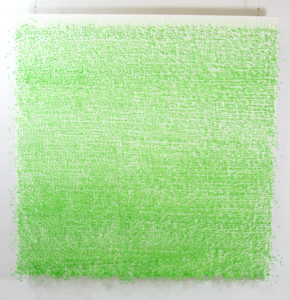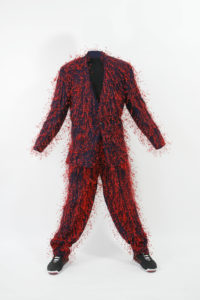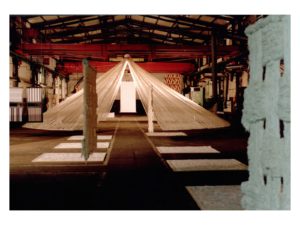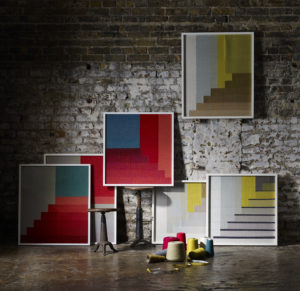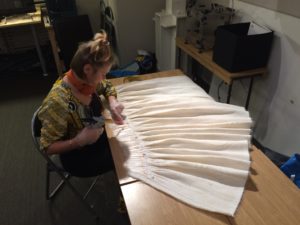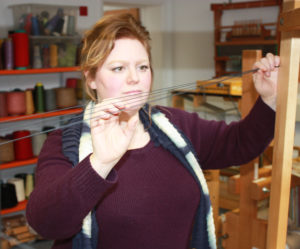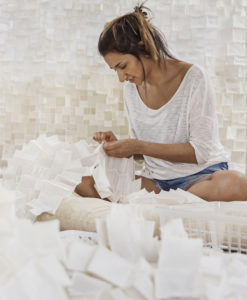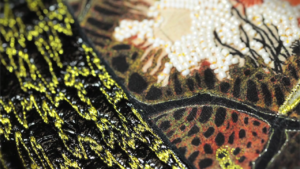
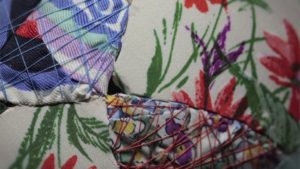

Credits from left to right: Stills from videos showing work by Louise Gardiner and Zoe Hillyard, and the creative duo behind R&A Collaborations.
While researching textile artists for our site, we came across a fantastic company called R&A Collaborations. Richard Foot and Arron Fowler make beautiful short films with a wide range of artists and makers showing their processes, motivations and work. We were so impressed we contacted them to find out more.
What exactly is R&A Collaborations and how did it start?
“R&A Collaborations is a story telling project by Richard Foot and Arron Fowler. We specialise in sharing the stories of Crafts people, Artists and Designers through short digital films. We are passionate about the promotion and support of makers and put a lot of time and energy into the softer side of our community, through advocacy, networking and events as well as education and training opportunities. Our journey began because of Helen Foot a very talented textile artist and more importantly sister of Richard. Helen was taking part in the Crafts Council’s Hothouse scheme in 2011. Helen asked us if we would like to help her make a film for an open call for “Power Of Making” an exhibition which was put on at the V&A. It was just for fun and so we decided to play around with our assets, my multidisciplinary media and moving image background and Richard’s photography experience, to try something that was comfortably in the middle. We made our first film using still images and have not filmed anything in the conventional manner since. Our process has been a constant learning curve, every success pushing us towards unforeseen issues, which in turn guided us into new areas of innovation. It has been a lot of fun and like all good things was entirely unplanned and surprising. Five years and over 100 films later we can still stand each others company and have amassed a great deal of talented and lovely maker friends.”
What are the advantages of a maker / artist having a film made?
“We have benefitted enormously from the recognition across all sectors of the power that film has to convey messages to online audiences. You hear it a lot, you have got to get a film onto your website! At the same time people feel an awful lot of pressure to make a film, as well as getting onto all, or any, of the other social media platforms. It is safe to say that a lot of people find it difficult to manage these perceived expectations. In truth most would rather be stuck in the back of a loom, or whatever other device is the key to their contentment and financial prosperity.
Having a well made film will give you an opportunity to communicate a message to your audience, with a richness and clarity that written text and photographs cannot. It is the closest medium we have which allows people to feel like they have met you, in the absence of actually meeting you. Having a badly made film will have just as powerful an effect on an audience, because in truth we watch and we judge. Better to not have a film, than to have one that detracts from our offer and does not convey the same level of quality you are striving towards in your products.
We use metaphors to help us understand other people’s processes. We have to get our heads around some fairly complicated work. So here come the film metaphors! Having a film made is much like buying a car, they are not all the same. Some are shiny, slick and well upholstered, with all the mod cons. Some are cheap and unreliable and destined to fail. That being said you can find bargains, and some expensive ones just won’t suit you, or go as fast as they claimed. The strategies and preferences of film makers are as varied as the textile community for sure. When you think of the range of scarves being woven around the world today for example, it is easy to imagine the range of thought processes, finishes, materials, machinery, techniques and skill that will be employed. Basically if you know nothing about film making, or film makers, then you will have to do some digging around if you want it to be successful. We have seen some lovely films made for free, by students or family friends, some awful films made by professionals for big money and vice versa. If you find someone and they make films that are similar in content, or tone, to your brand identity, then you are most of the way there.
Once you have a complete film and one that you are pleased with, it is time to reap the benefits. Sorry, back to car metaphors! If you get a shiny car and then leave it in the garage, don’t be surprised if no one sees it. Really the biggest challenge is to get the film seen. It takes persistence and luck to have your film seen by the people it is intended for. Our most successful films in terms of views have had a lot of luck and favours involved in their success. The film must be available and attached to you, on your website, Facebook, anywhere where people might end up when Googling your name. A film that is not being viewed is essentially the same as a film that does not exist.
The real advantages for a maker of having a film that really works for them is that they can turn strangers into informed clients, friends and advocates, without ever having to leave the studio. You can explain your process, values and products without having to remember all of the things you want to say, or worrying about saying them well. A well made film can communicate on your behalf and travel the globe in an instant. A well made film has the chance of teaching you something about yourself and your practice, that you did not know in advance of seeing it. The time and money that goes into making a film is ultimately worth it only if it is successful, makes you feel good and manages to keep itself alive and viewed.”
In an increasingly digital world do you see the work of makers / artists becoming more or less relevant?
“It goes without saying that the encroachment of the digital world is affecting us all in many ways. For us it has been extremely positive. There is no way our business could have existed 10 years ago, we are totally in debt to digital progression. Does it have an impact on the relevance of makers and artists? We think that the reality of relevance is an interesting one, we would hope that your work is so niche that it is virtually irrelevant to everyone. We strive to be irrelevant to most, but vital to a few. What really draws us into loving someone’s work, is when it hooks into some part of ourselves that we did not anticipate, when we see our world reflected in the understanding and expression of another human being. The more personal a reflection of the hands and psyche that made it, the better we like it. When striving to make interesting work, you are forced down a path of ever dwindling audience. The plus side of this is the people that love your work enough to pay for it, really, really love it. We own work that we did not like when we first saw it, only when realising the deeper connections to the reasons that the work existed, did we value it and need to have it in our lives. Ultimately when creating work that has the potential to become an heirloom in this increasingly throw away society, the ability to find that audience is hard. We think that the digital world has given us permission to be our own strange selves and to celebrate our quirks of habit and tastes. As makers we are given permission to let the people who are our own kind of weird, know that we exist, connect with us in meaningful and deep ways, in spite of borders and cultural barriers and ultimately indulge ourselves freely. The digital world is allowing us to be more irrelevant and potentially make a living from it.”
Your films cover a wide range of subjects, do you see any similarities in the personalities of the makers regardless of their genre? eg. creativity, passion,
“The big similarity that instantly pops up in conversation is that, almost without exception, the community of makers are extremely nice, normal and decent human beings. If it was not for the humility and kindness that we have always been greeted with, we doubt we would have ever found ourselves being so niche. It sounds a bit sickly and we resisted writing it down, but it is the most universal property we can think of. Many makers make work as a result of the same obsessions and the act of obsession does seem to be important to making. Be it vintage utilities, nature, distressed surfaces, clashes of colour, industrial buildings, whatever it is, we have met more than one person with the same obsession. It is endlessly fascinating to see how each individual expresses that obsession with their own medium. Most of the time you would be hard pushed to link those makers together from the final manifestation. Other than that it is the difference between makers that we are surprised about, even when we feel we understand someone’s practice. We are constantly surprised when capturing someone’s work, by just how varied and reflective of the individual, any medium of making becomes. The only other thing worth noting is that every maker says the same one line during the course of a days filming and that is “I should not really be doing this that way, it’s cheating.”
What have been your career highlights so far?
“We started with a big tick on the list when our first two films were shown at the V&A. It was the first validation of the value of our collaboration and gave us a solid reason to invest the time it took to develop our practice, from a fun experiment between friends, into a reliable product. When “Desire to Fly – Samantha Bryan” was selected as a Vimeo Staff Pick and the viewing figures started to sore, that was pretty exciting. Lots of good things came of it for Samantha and that was very satisfying. Our continued relationship with the Institute of Making (IOM) at UCL has been very important to our development. They are such an inspiring bunch of people and the IOM has become a sort of home from home. It has the unique property of being a welcoming place for all of our new found knowledge. It is the only place where we can talk about yarn, clay, wood, technology and anything else we have seen and become passionate about, where all of those things genuinely fit in and can be celebrated. Running the “Cinema of Making” for the past two years at MADE London has been great too. It was the first time we were made to feel like members of the Craft community, rather than voyeuristic outsiders. MADE London was the ultimate validation that we were where we belonged and that we are doing exactly what we are meant to be doing. Every maker that we visit gives us something to remember and cherish for life, we have seen beautiful work being made, visited amazing natural environments and fascinating buildings. We feel genuinely blessed to be so relentless exposed to life affirming experiences. Our top highlight is the friendships we get to keep forever, as we have been able to mutate client relationships into lifelong friendships.”
Do you have a big team?
“People are often surprised by the fact that it is just the two of us. We produce all of the content ourselves which includes the music. We can carry all of our equipment in one run and generally keep our work as low key as possible. We wouldn’t have it any other way. That way we can satisfy our inner control freaks. We don’t mind any one else contributing, as long as it is perfect and exactly what we would have done!”
Do you have any exciting plans or visions for the future of R&A Collaborations?
“We doubt it is exciting, but our top priority is making R&A Collaborations sustainable. It is a challenging time to be a creative person. The money fountains have long dried up. We face the same challenges as the makers we are making for. Making work we are proud of without selling out, the ultimate sustainability challenge.
The future is none the less bright and rich for us. We are making more films about talented people, most months have something in the diary and even 2017 has got something in it. We are diversifying our work into delivering conference speeches, running more cinema events, delivering creative workshops for the makers of the future and investigating many other avenues of potential. The truth is there is so much we could do, all of it has the potential to be beautiful and useful. As we approach our fifth anniversary we revel in the success we have achieved knowing that there is so much still to come, work to see and friends to make. What is not to like?”
www.racollaborations.co.uk
www.vimeo.com/racollaborations
www.facebook.com/racollaborations
www.twitter.com/racollaboration/ @racollaboration
